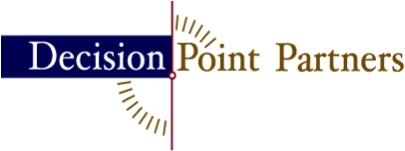The DPP Advantage
DPP is unique through our experience and expertise; derived from our team’s senior positions and accountability at broker/dealers, clearing/custodians, asset managers and technology providers. As leaders and doers, we are familiar with the pitfalls that can arise as well as the steps necessary to retain clients and colleagues through challenging transitions.
At Decision Point Partners, we will improve and integrate your platform, optimize the client/advisor experience and maximize your ROI.
Our Consulting Focus
- Custodians
- Wrap/Advisory Platforms
- DOL Fiduciary Rules
- Asset Managers
- Independent Broker Dealers
- Registered Investment Advisors (RIA's)
DPP’s involvement in all projects is always based on the same fundamentals:
Assessment & Analysis
What is your current state? What can we improve?
Recommendation
How can we help you achieve maximum value?
Implementation
How can we execute and integrate new process without disrupting clients?
Conversions
The biggest challenge clients face, and often ignore until late in the transition cycle, is managing the move from current state to future state without disrupting the current business, known as the Conversion State.
Armed with first-hand experience and knowledge, Decision Point Partners provides the senior direction and project management necessary to integrate the multiple work streams that are a part of any conversion, implementation and/or platform adoption project, while minimizing business disruptions and maximizing resources.
Technology Decisions
The DOL Fiduciary Law, (to be implemented by April 2017) is forcing change upon us - how is compliance achieved? With over 250 vendor platforms available, clients need the analysis and recommendation for the optimal solution for their firm’s needs.
At every decision point, we partner with you to provide you with our dedicated team that brings over 50 years of experience with major firms including Fidelity, Pershing , John Hancock, Manulife, RBC Wealth Management and Fiserv. Our team is passionate about ensuring the survivability of the advice-based financial services industry.
We leverage our expertise in managing changes in technology, processes, regulations and market environments, all of which, benefit our customers with practical recommendations and solutions.
Process Improvement
DPP’s approach to workflow analysis is focused on two key components “People & Process”, identifying and analyzing roles & responsibilities, as well as, the overall Business Process & Sub-Processes utilized to operate the customer’s daily business. A process is designed to ensure predictable, repeatable and consistent results.
Our workflow analysis begins by establishing a high level view of the overall “Business Process”, designed to ascertain a clear understanding and representation of the suppliers to this process: the Voice of the Customer (VOC) and the Voice of the Business (VOB).
We continue our analysis by defining the major process steps or “Sub-Processes” that make up the overall business process. We analyze each functional area to identify where each sub-process begins and ends, the suppliers and inputs for each area and the outputs and customers for that particular area. This provides clarity around the roles and responsibilities of each area and allows for accountability throughout the organization.
The final phase of our Business Process review is focused on determining if the Customer has achieved the desired end result(s). As previously mentioned the purpose of the business process design is to ensure repeatability and consistency. This should dramatically increase the probability that the Customer will have a positive experience. It is imperative to develop appropriate metrics to continually measure the effectiveness of the specific processes and overall customer satisfaction.
In order for the business process to be successful, there needs to be Process Ownership. The “Process Owner” is typically responsible and accountable for the entire business process. They manage the functional managers and staff through the operation of the process design and ensure the associates are well positioned to succeed. “Sub-Process Owners” operate more like the traditional Functional Managers, focusing more on the execution/performance of the sub-processes and developing subject matter expertise.

